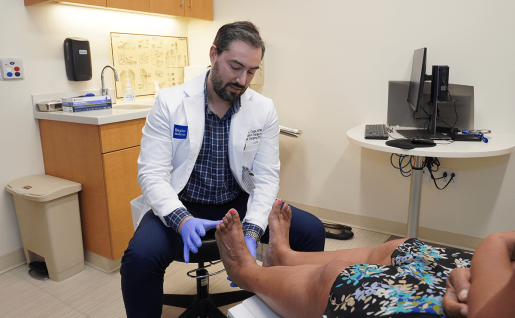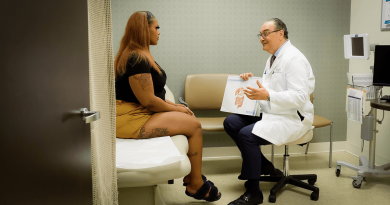The do’s and don’ts of diabetic footwear
Expert advice from a foot and ankle surgeon
When it comes to managing diabetes, proper foot care is crucial. Diabetes can lead to several serious foot complications. Neuropathy, a common issue, causes numbness and loss of sensation, making it difficult to detect injuries and leading to the development of foot ulcers that can become infected. Peripheral arterial disease (PAD) reduces blood flow to the feet, impairing the body’s ability to heal wounds and increasing the risk of gangrene. Foot ulcers, if left untreated, can progress to severe infections, potentially necessitating amputation.
 Diabetic foot problems can range from minor to severe, so making informed choices is essential when selecting shoes.
Diabetic foot problems can range from minor to severe, so making informed choices is essential when selecting shoes.
Dr. Tyler Coye, assistant professor of surgery in the Division of Vascular Surgery and Endovascular Therapy, is a foot and ankle surgeon specializing in diabetic limb salvage and shares advice on how to select footwear.
- Consult a podiatrist: Coye emphasizes the importance of consulting with a podiatrist before making any footwear decisions. Every diabetic patient has unique needs, and a podiatrist can provide personalized advice based on your condition, foot structure and lifestyle.
- Choose comfort: Comfort should be your top priority when selecting diabetic footwear. Choose shoes that provide ample cushioning and support. Coye suggests looking for options with extra padding and cushioned insoles to reduce pressure on your feet. Reducing pressure is important to prevent diabetic foot complications like corns, blisters or calluses from escalating into more severe problems and to ensure stability and protection for your feet.
- Proper sizing: Ill-fitting shoes can lead to a host of problems for people with diabetes. Make sure to have your feet measured regularly, as foot size can change over time. Choose shoes that fit well with enough room to wiggle your toes without being too loose. Shoes that are too loose can cause increased friction and shear, leading to blisters and calluses. These minor issues can rapidly escalate into severe problems like ulcers and infections, especially when coupled with diabetic neuropathy (nerve damage), which might cause patients not to realize the area is sore or injured. Furthermore, poorly fitting shoes may not provide adequate support and stability, potentially exacerbating foot deformities and leading to falls or other injuries.
- Breathable materials: Select shoes made from breathable materials like leather or mesh. Proper ventilation helps prevent moisture buildup, reducing the risk of fungal infections.
- Diabetic socks: Dr. Coye recommends wearing diabetic socks, which are designed to wick away moisture, provide cushioning and minimize friction. These socks are an excellent complement to diabetic footwear.
- Protective Features: Look for shoes with seamless interiors and no prominent stitching inside. These features reduce the chances of skin irritation, blisters and ulcers.
- Custom Orthotics: In some cases, custom-made orthotic inserts prescribed by a podiatrist can significantly improve comfort and reduce pressure points. These can be used in conjunction with diabetic shoes.
The Don’ts of Diabetic Footwear
- Avoid barefoot walking: Coye strongly advises against going barefoot, even indoors. Diabetic individuals may not feel minor injuries due to neuropathy, and walking barefoot increases the risk of cuts, scrapes and bruises.
- Stay away from high heels and pointy shoes: High heels and pointy shoes put excessive pressure on specific areas of the feet, leading to discomfort and potential foot problems. Look for shoes with a wide toe box and a low heel.
- Steer clear of tight or constricting footwear: Tight shoes can cause circulation problems, leading to poor wound healing in diabetic patients. Avoid shoes that squeeze your feet or have tight straps.
- No flip-flops or open-toed shoes: Flip-flops and open-toed shoes provide minimal protection and support. These types of footwear can increase the risk of injuries and infections.
- Don’t rely solely on fashion: While fashion is important, prioritize function over style when choosing diabetic footwear. Coye stresses that the health of your feet should always come first.
“Proper footwear plays a pivotal role in diabetic foot care,” says Coye. “By being mindful of your shoe selections, you can significantly reduce the risk of complications and ensure your feet remain healthy.”
Learn more about Baylor Medicine Vascular Health.
By Tiffany Harston, communications associate with the Michael E. DeBakey Department of Surgery



